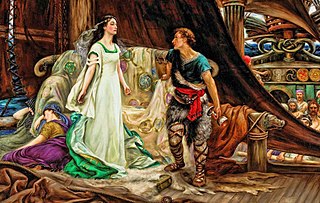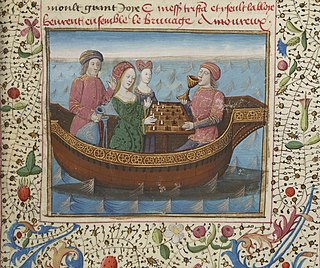Thomas of Britain (also known as Thomas of England) was a poet of the 12th century. He is known for his Old French poem Tristan , a version of the Tristan and Iseult legend that exists only in eight fragments, amounting to around 3,300 lines of verse, mostly from the latter part of the story. It is calculated that this represents about one sixth of the original.
Because Thomas has an "obvious dependence" on Wace's 1155 Roman de Brut , [1] Tristan was written between 1155 and 1160, possibly for Eleanor of Aquitaine, [2] since the work suggests close ties with the court of Henry II. Beyond this, his identity is obscure; it has been speculated that he is to be identified with the "Thomas" who wrote the Romance of Horn , but this is unsupported. [3] It is similar to the Tristan-story Chevrefoil by Marie de France, but either author could have borrowed from the other, or both from a third source. [4]
Although Thomas's own text is fragmentary, later adaptations of his work make it possible to reconstruct what is missing:
Thomas' version is the earliest known representative of the "courtly branch" of the legend, to which Gottfried's also belongs. This branch differs from the "common" or "primitive" versions of Béroul and Eilhart von Oberge, in that greater emphasis is placed on pleasing the sensibilities and expectations of a courtly audience. Some scholars have theorized an "Ur-Tristan", an original French version that inspired all later accounts. Joseph Bédier attempted to reconstruct this original from the evidence provided by the later versions.
This article contains information about the literary events and publications of the 13th century.
Poetry took numerous forms in medieval Europe, for example, lyric and epic poetry. The troubadours and the minnesänger are known for their lyric poetry about courtly love.

Tristan, also known as Tristram or Tristain and similar names, is the hero of the legend of Tristan and Iseult. In the legend, he is tasked with escorting the Irish princess Iseult to wed Tristan's uncle, King Mark of Cornwall. Tristan and Iseult accidentally drink a love potion during the journey and fall in love, beginning an adulterous relationship that eventually leads to Tristan's banishment and death. The character's first recorded appearance is in retellings of British mythology from the 12th century by Thomas of Britain and Gottfried von Strassburg, and later in the Prose Tristan. He is featured in Arthurian legends, including the seminal text Le Morte d'Arthur, as a skilled knight and a friend of Lancelot.
The lais of Marie de France are a series of twelve short narrative Breton lais by the poet Marie de France. They are written in Anglo-Norman and were probably composed in the late 12th century, most likely between 1155-1170. The short, narrative poems generally focus on glorifying the concept of courtly love by the adventures of their main characters. Marie's lais are thought to form the basis for what would eventually become the genre known as the Breton lais. Despite her stature in Anglo-Norman literature and medieval French literature generally, little is known of Marie herself, but it is thought that she was born in France and wrote in England.

Gottfried von Strassburg is the author of the Middle High German courtly romance Tristan, an adaptation of the 12th-century Tristan and Iseult legend. Gottfried's work is regarded, alongside the Nibelungenlied and Wolfram von Eschenbach's Parzival, as one of the great narrative masterpieces of the German Middle Ages. He is probably also the composer of a small number of surviving lyrics. His work became a source of inspiration for Richard Wagner's opera Tristan und Isolde (1865).

Iseult, alternatively Isolde, is the name of several characters in the legend of Tristan and Iseult. The most prominent is Iseult of Ireland, the wife of Mark of Cornwall and the lover of Tristan. Her mother, the queen of Ireland, is also named Iseult. The third is Iseult of the White Hands, the daughter of Hoel of Brittany and the sister of Kahedin.
Anglo-Norman literature is literature composed in the Anglo-Norman language developed during the period 1066–1204 when the Duchy of Normandy and the Kingdom of England were united in the Anglo-Norman realm.

Mark of Cornwall was a 6th-century King of Kernow (Cornwall), possibly identical with King Conomor. He is most famous for his appearance in the Arthurian legend as the uncle of Tristan and the husband of Iseult, the latter of whom engages with Tristan in a secret liaison, giving Mark the epithet Cuckold King.

As a literary genre of high culture, heroic romance or chivalric romance is a type of prose and verse narrative that was popular in the noble courts of High Medieval and Early Modern Europe. They were fantastic stories about marvel-filled adventures, often of a chivalric knight-errant portrayed as having heroic qualities, who goes on a quest. It developed further from the epics as time went on; in particular, "the emphasis on love and courtly manners distinguishes it from the chanson de geste and other kinds of epic, in which masculine military heroism predominates."
This is a bibliography of works about King Arthur, his family, his friends or his enemies. This bibliography includes works that are notable or are by notable authors.

Tristan and Iseult is a chivalric romance told in numerous variations since the 12th century. The story has had a lasting impact on Western culture. The tale is a tragedy about the illicit love between the Cornish knight Tristan (Tristram) and the Irish princess Iseult. The story depicts Tristan's mission to escort Iseult from Ireland to Cornwall to marry his uncle, King Mark of Cornwall. On the journey, Tristan and Iseult ingest a love potion, which results in their forbidden love.

The Prose Tristan is an adaptation of the Tristan and Iseult story into a long prose romance, and the first to tie the subject entirely into the arc of the Arthurian legend. It was also the first major Arthurian prose cycle commenced after the widely popular Lancelot-Grail, which influenced especially the later portions of the Prose Tristan.
Tristan is a Knight of the Round Table in Arthurian legend.
Eilhart von Oberge was a German poet of the late 12th century. He is known exclusively through his Middle High German romance Tristrant, the oldest surviving complete version of the Tristan and Iseult story in any language. Tristrant is part of the "common" or "primitive" branch of the legend, best known through Béroul's fragmentary Norman language Tristan. It is German literature's first rendition of the story, though Gottfried von Strassburg's Tristan, part of the "courtly" branch, is more famous and respected.
Brangaine is the handmaid and confidante of Iseult of Ireland in the Arthurian legend of Tristan and Iseult. She appears in most versions of the story.

The riddarasögur are Norse prose sagas of the romance genre. Starting in the thirteenth century with Norse translations of French chansons de geste and Latin romances and histories, the genre expanded in Iceland to indigenous creations in a similar style.
Brother Robert was a cleric working in Norway who adapted several French literary works into Old Norse during the reign of King Haakon IV of Norway (1217–1263). The most important of these, Tristrams saga ok Ísöndar, based on Thomas of Britain's Tristan, is notable as the only example of Thomas' "courtly branch" of the Tristan and Iseult legend that has survived in its entirety. It was the earliest Scandinavian version of the story, and is thought to be the first Norwegian adaptation of an Old French work. Its success may have inspired the spate of translations during King Haakon's reign.
Béroul was a Norman or Breton poet of the 12th century. He wrote Tristan, a Norman language version of the legend of Tristan and Iseult of which a certain number of fragments have been preserved; it is the earliest representation of the so-called "vulgar" version of the legend. Eilhart von Oberge wrote a treatment of this version in German, and many of Béroul's episodes that do not appear in Thomas reappear in the Prose Tristan. Beroul's poem survives in a single manuscript now in the Bibliothèque Nationale in Paris. This copy is poorly written and there is a suggestion that part of the poem was written by a different scribe from the rest. The actual content of the poem also differs from the modern conception of what a narrative poem should be; the plot is disjointed and lacking in a flow of cause and effect, and the characters are poorly defined. Nevertheless, Fedrick proposes that this was common of literature in Beroul's time.
The Folie Tristan d’Oxford, also known as the Oxford Folie Tristan, The Madness of Tristan, or Tristan’s Madness, is a poem in 998 octosyllabic lines written in Anglo-Norman, the form of the Norman language spoken in England. It retells an episode from the Tristan legend in which Tristan disguises himself as a madman to win his way back to Ysolt. The poem can be dated to the period 1175–1200, but the name of the author is unknown. It is not to be confused with the Folie Tristan de Berne, a different medieval poem on the same subject, each work taking its name from the city in which the manuscript is now kept.
In the Middle High German (MHG) period (1050–1350) the courtly romance, written in rhyming couplets, was the dominant narrative genre in the literature of the noble courts, and the romances of Hartmann von Aue, Gottfried von Strassburg and Wolfram von Eschenbach, written c. 1185 – c. 1210, are recognized as classics.